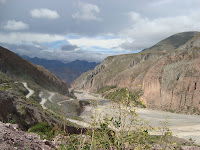Tilcara is a very touristy small city and we just came when a music festival was starting. So young people were coming from all the department to party, and all the hostels were full. It ended up that the hostel didn’t receive my booking and was full. But the guy in charge helped us to find 4 beds (the last ones!) in an another hostel. Oufff!!! Founded in 1586, the city has the name of its first indigenous inhabitants. In the main square, there were a market so we decided to start shopping. In the North, they are selling beautiful pullovers, socks, hats and gloves made of llama wool. They are well know too for products in leather: hat, belt,… Stephanie and me bought a cowboy hat and belt, yeahhh Indiana Claire is back!
with my new pullover :) - where we slept at night (down)
The next day, we went to visit the archeological site of Pucara, a pre-Inca fortification. Traces of human habitation in the area date back more than 10,000 years. The fortified town was originally built by the Omaguaca tribe, who settled in the area around the 12th century. Experts in agriculture, weaving and pottery, they were also renowned warriors. During their time, the pucará served as an important administrative and military center. At its peak, the pucará covered up to about 15 acres (61,000 m2) and housed over 2,000 inhabitants, living in small square stone buildings with low doorways and no windows. Besides living quarters, the pucará contained corrals for animals, sites to perform religious ceremonies and burial sites. In the late 15th century, the tribes of the Quebrada were finally conquered by the Incas under Tupac Inca Yupanqui, who used the pucará as a military outpost and to secure the supply of metals such as silver, zinc and copper which were mined nearby. The Incan domination of the area only lasted for about half a century, and ended with the arrival of the Spanish in 1536, who founded the modern town of Tilcara in 1586. In 1908, the ethnographer Juan Bautista Ambrosetti rediscovered the site.
Indiana Claire is back!
We had decided to go to Iruya, a small village in the mountains. But the only access is by a dusty road and we heard from a French couple that four days ago the road collapsed and that you couldn’t go all the way. So we asked around but nobody knew anything. So we decided to go and see… we stopped on the way in Humahuaca for lunch which has a beautiful church. The last 45 kilometers are only dusty road climbing up the mountains to 4000 meters high. I got nicely surprised by the efficiency of the Argentinean on the road. The road collapsed and four days ago it was fixed, not like in Guatemala where you can wait for months… and everywhere we saw people cleaning the road.
typical mountain houses (up) - dancing on the road to Iruya (below)
The road goes up to 4000 meters high (up) - the valley of Iruya (down)
We arrived in Iruya on the afternoon. Iruya's name is derived from the Quechua language, meaning "brave straw" or "site of the high pastures”. With a population of less than 5000 people, the village sits nestled against the mountainside at an elevation of 2,780 meters. We stayed in a very nice hotel (our little treat!) with beds so comfy that it was hard to get out of bed in the morning (isn’t it Christine?)!
the hotel outside (up) - the living room (down)
On the 11th of January, we headed back down to go to Purmamarca. We made a reservation in the morning in a hotel but we never found it! I don’t know what was going on with reservations, but were so unlucky. But we found another place to stay close to the main square. Purmamarca means "Town of the Virgin Earth", in aimará and it is a small town framed by spectacular hills of colors, unique in all the country known as «The mountain of the seven colors». In the main square, there is an artisan fair every day, with typical handmade products of the Quebrada, such as carpets, diverse wood statues, local clothes, vessels and medicinal plants. At night we went to a nice restaurant with live music and enjoyed it a lot... until we got the bill!!! They were charging AR$10/personne for the spectacle without telling us. I hate that but paid.

















No comments:
Post a Comment